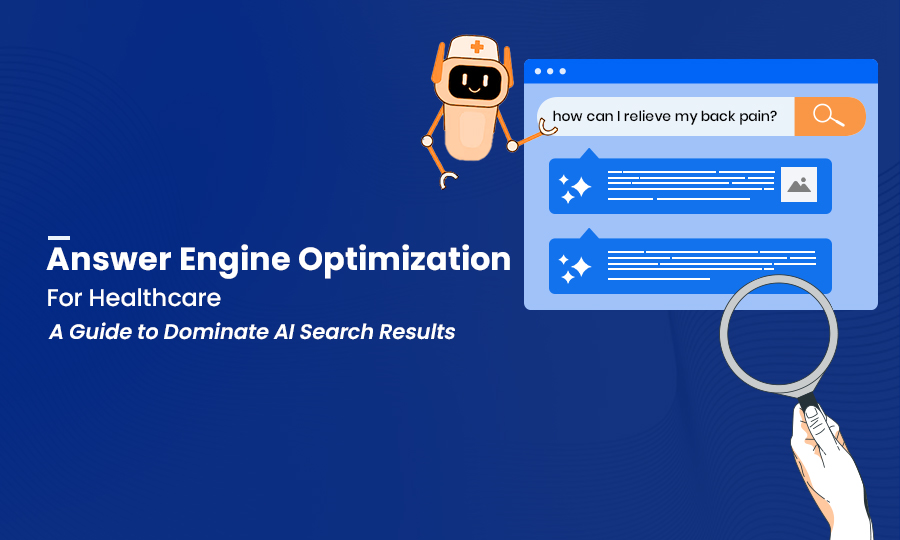Healthcare businesses mostly rely on search engine optimization (SEO) to establish a robust online presence and grow their patient base. One of the latest advancements in today’s competitive AI-driven search landscape is the increasing utilization of answer engines for online healthcare searches. It has made answer engine optimization for healthcare practice crucial.
Nowadays, people prefer to use answer engines like ChatGPT, Perplexity, and other AI chatbots to get specific and accurate AI-generated answers to their healthcare queries.
A 2024 study claimed that nearly 20.5% of internet users prefer to use voice search tools like Google Assistant and generative search engines like ChatGPT to get quick answers to their search queries.
Here in this blog, we will provide you with a complete guide to AEO. You’ll learn about how AEO will work for your medical practice, the benefits you can achieve, and how you can optimize your practice for these answer engines.
What Are Answer Engines?
Advanced online platforms that provide specific answers to various user queries are called answer engines. Some examples of popular answer engines include:
- Voice assistants like Google Assistant, Siri, and Alexa
- Generative search engines like ChatGPT, Gemini, Perplexity AI, Copilot, and other AI chatbots embedded in websites or apps, from which you must prioritize generative engine optimization
- Q&A Platforms like Quora and Reddit
Search engines like Google, Yahoo, and Bing show multiple websites in blue links as the result of users’ healthcare queries. Unlike these traditional search engines, answer engines provide human-like and AI-generated responses to healthcare queries based on AI, machine learning, and natural language processing.
For example, Google provides a link to various websites when a patient searches for ‘ ’ The patient needs to browse endless search engine results and find the answer they need. But answer engines will provide direct and precise answers to the patient’s queries.
What Is Answer Engine Optimization?
It refers to a process where you need to optimize your web content strategically so it can be selected as a direct answer by answer engines. When you optimize your site for answer engines, you increase the chances of your site getting featured on quick snippets, knowledge panels, and position zero.
What makes AEO unique from traditional SEO is its focus on targeting snippet-like results to answer a user’s query directly. Now you may be thinking what answer engines are.
What Is Answer Engine Optimization for Healthcare?
It focuses on structuring and optimizing the website content of a healthcare business to directly answer user questions through AI-driven platforms. It complements traditional SEO and ensures your healthcare website’s content is easily accessible and understandable for both users and AI systems.
This practice increases online visibility of your healthcare content in featured snippets, voice search results, and AI-driven overviews. If you optimize your healthcare content for answer engines, it has a higher chance of appearing at the top of SERPs.
2 Major Types of Answer Engines Optimization (AEO) for Healthcare
There are two major types of answer engine optimization that healthcare businesses can prioritize. We have mentioned these two major types here with some significant details. Let’s have a look.
1. Voice-based AEO
Voice-based answer engine optimization for healthcare refers to the process where you need to create content that answers the queries users ask of voice search tools like Google Assistants, Siri, and Alexa. These questions must be voice-based and spoken queries.
Healthcare professionals must incorporate natural language processing and voice recognition technology in their content. Similarly, their content must give precise answers for voice search results.
2. Text-based AEO
Healthcare practitioners need to write content for their website and ensure it can provide clear and concise answers. The content must answer the user’s text-based queries that they enter into the search engines like Google’s search bar.
It will help the search engines easily find your content and feature it on the direct responses or quick snippets. Effective keyword research and structured data markup must be implemented to optimize your healthcare content for text-based AEO.
From SEO to AEO: The Significant Shift for Healthcare Content
In previous times, when we needed any information, our first destination to seek answers to our queries was Google.
But now the scenario has completely changed.
People no longer want to find their desired information among the endless website links; they seek quick and brief answers to their queries. People no longer want to type their queries with proper keywords, search for the correct information, and click on every link to find their desired information.
Thus, they turn to answer engines like voice assistants, Q&A forums, and AI chatbots.
The search engines also have evaluated their algorithms and are trying to deliver the best results and precise responses to the user queries. As more people have started to use these answer engines to find healthcare information, healthcare businesses must adapt to the change and upgrade their content strategy.
In the past few years, healthcare marketers and business owners have realized the significance of optimizing their content for answer engines.
Let’s find out how healthcare marketers can adapt to this significant change.
- They need to think beyond the traditional search engines.
- With SEO-optimized content creation, they need to craft content that can be suitable for the direct responses of answer engines.
- Healthcare professionals must focus on creating content in natural language terms rather than relevant keywords.
- It will not only help the healthcare business to gain an exceptional online visibility but also engage more potential patients, specifically those who prefer to get quick, precise answers.
- They need to write high-quality content in a way that can deliver human-like answer engine responses.
Why Healthcare Businesses Must Shift Their Content Strategy from SEO to AEO?
The following are some crucial reasons why healthcare professionals must change their content strategy to thrive in today’s competitive digital era. Let’s have a look.
- Direct Answers
Answer engine optimization for healthcare content provides a direct answer to the user’s queries. They get specific answers and don’t need to visit separate websites to find the information anymore. As most internet users have shifted to zero-click searches, your AEO-optimized healthcare content can naturally grab the attention of the majority.
2. Reduced Time
AEO understands the search intent of the users. It gives a direct response, reducing the user’s time to surf too many websites.
For example, a patient searches for ‘physical therapy exercises for home’. AEO understands that the patients seek information about physical therapy exercises they can do at home. It comprehends that the patient doesn’t need the information of a physical therapist or the services.
3. Accurate Information Delivery
As AEO gives specific responses, it prioritizes data-statistics-based copy. Furthermore, your healthcare content can be selected by the answer engines as their response if you write it accordingly.
According to a research result, featured snippets get nearly 8.6% of all clicks. When your healthcare content is featured in these snippets, they are more likely to get clicked by your potential patients.
4. Multi-platform Delivery
AEO showcases your healthcare content across various online platforms, such as voice assistants and Google’s featured snippets. This will significantly increase the visibility of your content and showcase your practice as a knowledgeable medical resource.
How Does AEO Work for Your Healthcare Business?
Answer engines function based on their advanced algorithm.
So, how does the algorithm work?
Firstly, it analyzes the user intent behind a healthcare query and delivers the most relevant answer. They mostly focus on the content that can specifically be fit into the answer boxes. The content may include definitions, steps, or other specific answers.
Healthcare practitioners can combine their SEO strategy with AEO for maximum impact. It will increase the online visibility of your practice across online platforms and drive organic traffic to your site.
Here’s a brief example of how answer engine optimization will work for your healthcare business.
1. User Query
For instance, a patient has entered a search query. Answer engines examine it to understand why the patient has searched for that specific thing. When it identifies the intent, it determines the most accurate response to that query. The queries can be simple questions to know healthcare information or even complex inquiries related to any multi-faceted topic.
2. Rich Snippets and Direct Answers
When the answer engines identify the relevant content to show in their direct responses, they may show it as:
- Lists
- Tables
- Steps
- Points
Because it will make the complex healthcare content more easily consumable for the patients and other people.
A bonus tip: Answer engines often take these answers from structured data like FAQ content, How-to guides, and easy steps. So, healthcare professionals can focus more on such content to get it selected by answer engines as their responses.
3. Data Collection
As we already mentioned that answer engines scan the web to collect data that can perfectly fit into their direct answer boxes. Similarly, the content must address the query. Answer engines mostly collect the data from structured content, clear information, complex content easily explained through brief steps, and authoritative sources.
4. Ranking Factors
Answer engines check a variety of factors before they decide to make specific content appear in a certain order. It analyzes the relevance, source, and clarity of the content. They also check whether the content can be fitted into the answer snippets.
Answer engine optimization for healthcare requires you to create structured data so that it can get featured in the snippets.
Understanding the Healthcare Audience’s Search Behavior
When you want to develop strategies to ensure the success of your answer engine optimization, you need to identify your target audience and their online search behavior. The process is quite crucial, but can be performed effectively with a strategic approach.
Here is a quick step-by-step guide to understand your healthcare audience’s search behavior so that you can tailor your content to meet the requirements.
Step 1: You need to use keyword research tools like SEMrush and Google Keyword Planner to identify the common phrases people are using when they search for healthcare information. Track the ranking difficulty and search volume of those most-searched keywords.
Step 2: Personalize your healthcare content based on those keywords and topics. For instance, a pediatric dentist has identified the increased searches for ‘common dental issues a toddler can experience’. The dentist can create content that addresses that specific concern.
Step 3: The next thing you can do is to monitor the social media platforms and other online forums to identify the latest trends, discussions, and emerging concerns regarding your healthcare practice niche.
Step 4: Track the likes, shares, comments, and feedback on the content you post on your social media page. It will reveal how your audience reacts to the healthcare content you share and whether it resonates with your audience or not.
Step 5: Track the engagement of your healthcare content, no matter where it is shared.
Step 6: Once you have a clear idea of who your audience is, you need to segment the audience based on their demographics and geographic factors like their location, age, gender, income level, online behaviors, and healthcare concerns.
Types of Healthcare Audience and What They May Search for
According to a study, 7% of all Google searches are health-related.
So, who are these people who search for healthcare information online? There are some major types of audiences your healthcare business can have.
Here is a list of the most significant categories of audience and an overview of the reasons why they search for healthcare information online.
1. Healthcare Professionals
They can be doctors, nurses, specialists, and other medical staff who are directly associated with patient care. They can conduct online healthcare searches to gain valuable insights about the latest medical advancements, new treatments, and studies.
2. Healthcare Organizations
Medical organizations like hospitals, clinics, pharma companies, and health insurance businesses can search online for healthcare information to improve their event-led growth. They may search for the latest trends in the healthcare industry, the new technologies, compliance and regulatory updates, and strategies through which they can optimize their operations.
3. Patients and General Audiences
They can be individuals who are suffering from chronic illnesses and want to seek medical assistance to improve their wellness. It is also possible that the general public simply seeks information about their health through online searches. For their close ones, people can search online for health tips, healthcare professionals, wellness services, and products.
4. Healthcare Marketers
This specific group includes the digital marketers who work for healthcare professionals and organizations to boost their online presence. They often seek online healthcare information to analyze new industry-related trends and medical consumer requirements. Additionally, the marketers may want to learn new healthcare marketing strategies to improve the outcome of their campaigns.
How to Do AEO Optimization for Healthcare Practices: 12 Effective Strategies
Want to create a significant impact in the competitive healthcare industry?
If yes, you must transform your content strategy and optimize your digital presence for answer engines. But this requires you to follow a strategic approach to perform answer engine optimization for healthcare effectively.
Here, we will discuss the top 12 helpful AEO strategies for healthcare experts to make their content visible in the most prominent position of a search engine result page. Let’s dive into the details.
1. Identify Your Target Audience

No matter what strategy you will implement for your healthcare content, you must have a clear idea of the audience whom you want to target. Additionally, you need to understand what and why your target audience is asking related to your healthcare practice niche.
A study has claimed that 80% of consumers prefer to purchase from a business that offers them personalized experiences. This statistic shows how important it is for healthcare professionals to offer personalized content for their potential and existing patients.
And this can only be achieved if they correctly identify who their target audience is.
Google Search Console is one of the most beneficial tools that you can use to find out what people want to know when they visit your website. Here’s a brief explanation of the process.
- You need to log in to your Google Search Console account and navigate to your website.
- Then go to the dashboard and click on the tab named ‘Performance’.
- When you click on the tab, you’ll find certain sections like ‘Queries’, ‘Countries’, and ‘Pages’.
- You can find the list of search terms or keywords that users have used to find your healthcare website.
- Now it’s time to filter and sort the keyword list based on different key metrics like impressions, clicks, and CTR.
- The next process is quite complex, but you can follow it accurately if you have a clear idea of it. Analyze the filtered data to identify the queries that bring the most traffic to your site.
- You can also find out which queries have generated the most clicks and which keywords are undeserved.
This process will help you understand what people are searching for on your healthcare website.
2. Target Specific Questions
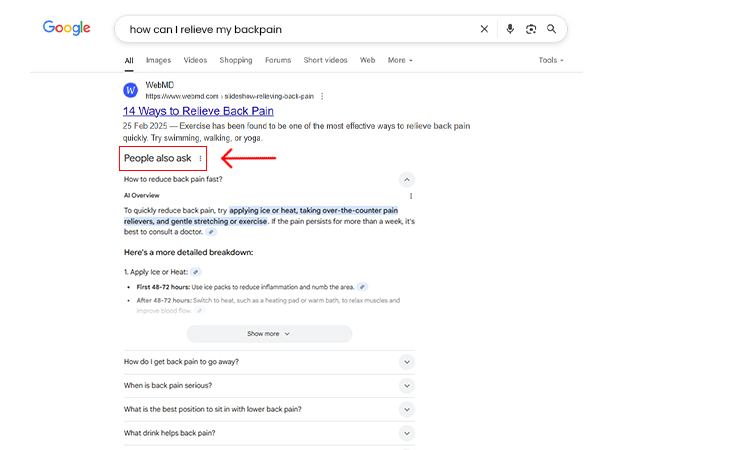
The base foundation of answer engine optimization for healthcare practices relies on what people search for related to a topic. It can be about a healthcare professional, a medical organization, medical services, or even some
Unless you don’t have a clear idea of what people want, you cannot accurately optimize your content to make it featured in the answer snippets.
We suggest that you focus on the type of questions your target audience searches for related to your healthcare expertise. You can use tools like AnswerThePublic or Google’s ‘People also ask’ section to identify the common queries related to your niche.
How to Use AnswerThePublic to Identify Common Healthcare Queries?
Below, we have mentioned the process of how healthcare experts can target specific questions in their content and rank it for featured snippets or direct answers.
- Type the Keyword – You need to type the seed keyword or phrase in the search box of this tool and select the country and language you want to target. Hit the ‘search’ button to get the list.
- Browse the List – AnswerThePublic will analyze the autocomplete data from different search engines related to your keyword and provide you with a list of queries. You can browse through it to identify the most beneficial ones for your healthcare content.
- Identify the Queries – You’ll get to see the questions related to your healthcare website. The starting words of those phrases will be what, why, where, how, can, and the like.
- Track the Green Circle – Consider a higher number of searches for a specific keyword if you notice a darker green circle beside it.
- Identify the Prepositions – You need to identify the prepositions in the queries, such as near, for, to, with, and nearby. Most of these queries are particularly to find a local healthcare business.
- Compare the keywords – You can compare the keywords with similar ones. The list will follow alphabetical order from A to Z.
- Check the Suggested Keywords – You can also check the list of suggested keywords related to your primary keyword.
Similarly, there is a section called ‘People also ask’ towards the end of a Google search results page. You can search for a specific keyword related to your healthcare niche. In this section, you can get a list of some most-searched keywords related to your search.
3. Set a Clear Goal

Now you’ve got the list of queries that you must address through your healthcare content. It’s time to set the goal – ‘what do you want to achieve through your healthcare AEO optimization?’ As a healthcare professional, you must determine:
- What goals can define the success of your healthcare answer engine optimization?
- What metrics will measure your AEO performance?
- What do you want to achieve through the optimization of your healthcare content for answer engines?
- to generate qualified leads
- to acquire new patients and attract inquiries
- to drive organic website traffic
- to increase content engagement
- to increase online visibility
- to provide a better user experience
- to build credibility and authority
Tip for you: We suggest you set modest goals that you can achieve easily with AEO, as this process of answer engine optimization for healthcare is a relatively newer content strategy with limitations.
You can set your goals to earn 1-2 mentions for a set of user queries. Additionally, you can set goals for citations, brand mentions, and referral traffic.
Healthcare specialists can plan to achieve the goals within three to six months at the initial stage. However, the timeline must provide some insights, like the amount of referral traffic they have achieved through answer engines.
4. Develop a Robust Strategy

Healthcare professionals must develop an effective strategy before they proceed with the content optimization process. They need to start with –
- Firstly, healthcare professionals must audit their website’s existing SEO and identify the areas of improvement.
- Then it’s crucial to target the conversational questions. For instance, queries can be of two types. People may search for ‘home remedies for arthritis’, while others can search for ‘how I can relieve my arthritis pain at home?’ You need to target the second type of conversational queries through your content.
- Healthcare experts need to identify their target patient market’s preferences for different search engines like Google, Bing, Meta AI, ChatGPT, voice assistants, and Claude.
- They can also track and analyze their market competitors’ visibility on the answer engine’s direct responses.
You need to analyze whether –
- Do you need to focus on Meta AI visibility as your target audience prefers to use that for healthcare searches?
- Do you prioritize repairing your site’s SEO issues first before you proceed with the AEO optimization?
- Between AEO and SEO, which type of content optimization must be on your priority list?
This analysis will help you develop a robust strategy and maximize the effectiveness of your healthcare answer engine optimization.
5. Conduct a Thorough Keyword Research based on User Queries

This strategy is extremely crucial to achieve a position for your healthcare content in the answer engine’s direct responses.
Wondering what a keyword is?
Keywords refer to the phrases or terms that users often use to find specific information.
For example, a patient who wants to seek gynecology treatment services can search for the keywords ‘best gynecology treatment near me’. This phrase that they type in the search engines, like Google, is called keywords.
When you optimize your healthcare content with the same keyword, your content ranks in the user’s online search results. Similarly, you need to find the keywords that your target audience uses to ask healthcare queries online.
Effective healthcare keyword research strategies can help you find the most-searched query terms related to your niche. No matter which tool you use, the process is quite similar for keyword research, which follows –
- You need to enter the primary or seed keyword related to your healthcare niche in the keyword research tool. For instance, a pediatrician will enter keywords like ‘pediatric services’, ‘top pediatricians’, or ‘pediatric specialists’.
- The tool will provide you with a list of phrases related to your primary keyword.
- With these tools, you can also check the search volume and difficulties of those keywords. Search volume is how many times a keyword has been searched for, while keyword difficulty is how difficult it is to rank for those keywords.
- The higher the percentage you see for a keyword under the keyword difficulty section, the more difficult it is to rank for.
- These tools will also help you identify the intent behind those healthcare search queries. Questions like ‘what is the best med spa clinic in town’ have commercial search intent, informational search intent can sound like ‘how to choose the right chiropractors for myself?’
The following are some examples of search intent. Understanding user intent is important as you can choose the right keywords after you get a clear idea of them.
- Informational: ‘What is a root canal surgery?’ or ‘tips for physical exercises at home’.
- Navigational: ‘dental treatment services of XYZ hospital’
- Transactional: ‘cost of med spa treatments’ or ‘book appointment for plastic surgery consultation’.
- Commercial: ‘best health insurance provider near me’, ‘top hospitals in my town’.
Keyword research is crucial for answer engine optimization for healthcare practices. Because it will help you identify the search intent of the users and craft different types of content to attract them.
- Informational search intent – Comprehensive healthcare guides and informative blogs
- Navigational search internet – Medical Tutorials and how-to guides
- Transactional search internet – Medical service comparisons and reviews
- Commercial search intent – Promotional pieces to showcase the USPs of your treatment services
Furthermore, healthcare professionals need to identify if their target keyword triggers featured snippets, direct responses of voice assistants, and people also ask boxes.
How to Use a Keyword Research Tool?
Though there are a few significant tools like Google Keyword Planner and SEMrush to find relevant healthcare keywords. We have explained the process of using SEMrush for effective keyword research, as this tool is preferred by over 10 million digital marketers.
The easy-to-follow process will help you identify the most-searched keywords related to your healthcare niche.
Suppose you want to write a blog on ‘top 10 benefits you can achieve through regular dental cleanings’. Then you need to find the primary and secondary keywords that users have mostly searched for related to this specific topic. Follow the below-mentioned steps to use SEMrush for your AEO keyword research.
- Open the SEMrush tool and log in to your account or open an account if you don’t have one.
- Click on the ‘Keyword Magic Tool’ that you’ll find on the left side of the dashboard.
- After that, you need to enter the seed keyword, such as ‘benefits of dental cleanings,’ and select the region that you want to target.
- Click on ‘search’ and you’ll get a list of other keywords related to the primary one. Those keywords are used by the users of your target region.
- Then you need to select ‘question’ so it will provide a list of relevant online queries.
Factors You Must Know Related to Healthcare Keyword Research for AEO
There are certain factors that you must have a clear idea about before you proceed with your keyword research. Let’s have a look.
- Keyword Gap or Missing Keywords – Specific phrases on your competitors’ websites have ranked for, which you haven’t incorporated into your content.
- Weak Keyword – Phrases where your competitors outrank your healthcare practice.
- High Search volume – Specific keywords that are searched for the highest time.
- Lower Keyword Difficulty (KD) – Easy to rank keywords; ideal for healthcare professionals who have just launched their site
Best Ways for AEO Keyword Research for your Healthcare Practice
Explore some useful tips and tricks of AEO healthcare keyword research.
- Healthcare professionals must focus on long-tail keywords rather than short-tail ones as the first one often has less competition. For example, keywords like ‘benefits of seeing a dermatologist’ will be more effective than broad phrases like ‘dermatologist’.
- They need to sort the keywords based on the user’s search intent.
- Healthcare professionals need to choose keywords in natural and conversational language. These keywords will help you optimize your content for voice search.
- Regularly monitor the performance of these keywords to refine your AEO keyword research strategy.
6. Focus on Natural Language Content

Natural language plays a crucial role in answer engine optimization for healthcare. The practitioners must write their content in a conversational tone that their potential patients may use to ask their medical queries.
Such content will make the users feel like they are having a conversation with someone. Additionally, it is important to incorporate long-tail keywords to keep the content conversational. Relevant phrases that people mostly use in their conversations and voice searches can also be helpful in this regard.
For example, you can optimize your healthcare content for ‘what are the best dental care practices to maintain great oral health?’ rather than ‘dental care practices for great oral health’.
Tips to Write Content in Natural Language
Here are some useful tips to craft healthcare content in natural and conversational language.
- You need to address general yet engaging questions in your medical content.
- Ask questions in between to keep the readers engaged throughout the content. This tip works best when you write about complex healthcare topics like medical treatment procedures.
- Try to avoid complex words and medical jargon that the common people may not be aware of. You need to write the content in the language that people often use in general communication with others.
- You can craft engaging short and mid-size sentences to keep the content easy to understand.
- You must add phrases like ‘why’, ‘how’, ‘what’, ‘can’, and other query-related terms in your content to make it suitable for answer engines’ direct responses.
- Additionally, you can use active voice to make the sentences more conversational.
- Personal pronouns are your best friend here. You must add the term ‘you’ while communicating with the readers through your medical content.
7. Create Content for Direct Answers
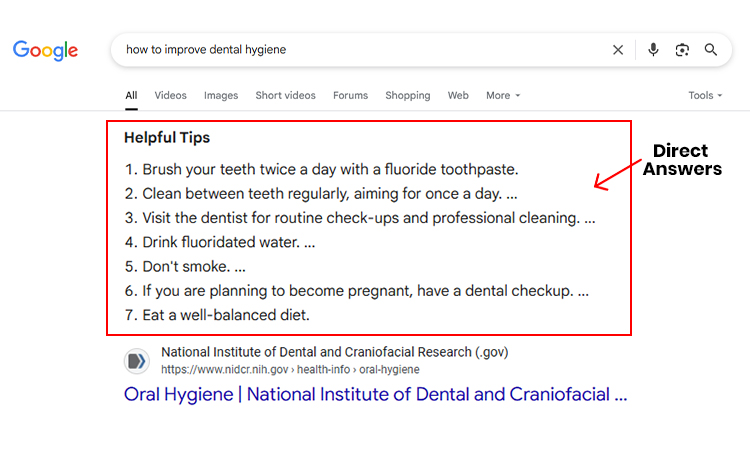
Content creation is not enough for answer engine optimization. Unless your content gets featured in the answer snippets of search engines or direct responses of voice assistants, the content will not be considered suitable for your AEO and online marketing efforts.
Follow the steps below to create healthcare content that can be featured as direct answers.
- Healthcare professionals need to directly address the common users’ queries related to their expertise and services.
- You need to structure your content and provide valuable information accordingly, as the featured snippets are mostly of 40-50 words.
- We suggest you format the answers in a more consumable way, such as through bullet points, lists, steps, and tables.
- No matter how concisely you create content, you must thoroughly research the topic and provide accurate data in this.
- You can craft frequently asked questions (FAQs) and How-to guides to target the featured snippets. Because search engines can easily collect data from such content and show it as direct responses.
8. Use Structured Data and Schema Markup

Did you know that 36.6% of Google search results include at least one snippet with information derived from schema markup? Thus, schema markup and the right utilization of structured data are important in answer engine optimization for healthcare businesses.
What is schema markup?
It’s a special code that helps search engines understand what specific content conveys. It’s like adding some extra labels to your information to make it more specific. So that the search engines and AI answer engines can easily comprehend the content.
What is structured data?
The concept of structured data is the same as schema markup, as it helps answer engines extract data from your content and show it in the featured snippets. Implementing structured data can help healthcare experts deliver an exceptional user experience and improve the online visibility of their practice.
Note: You can use the FAQ schema to answer the most commonly searched questions related to your healthcare niche. You can add FAQ pages in the site where you’ll add only the frequently asked questions. A how-to schema with step-by-step instructions can be beneficial to make your content appear in the featured snippets.
Why? You can type a query in Google and notice that most of the featured snippets contain brief steps and quick answers to user queries.
9. Optimize Your Healthcare Content for Featured Snippets
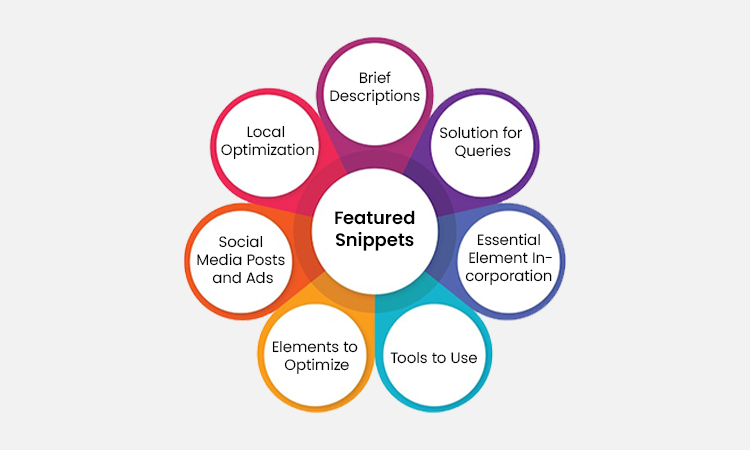
Optimization for answer engines is quite different from SEO optimization. We have discussed some beneficial ways of healthcare content optimization for featured snippets. Let’s have a quick look.
- Brief Descriptions – Your medical content must be based on clear concepts and contain brief descriptions of the essential data.
- Solution for Queries – Your content must answer or provide the solution for healthcare search queries.
- Essential Element Incorporation – You need to add bullet points, lists, tables, and short paragraphs in your content like blogs. Additionally, a summary box for quick answers will be great if the topic is complex and you want to provide the readers with an easy overview of your content at first. You can arrange your content in tables to compare information.
- Tools to Use – Analytical tools like ‘People also ask’ and a question-based website like Quora can help you get an idea of the type of content you need to craft for your healthcare site.
- Elements to Optimize – You need to strategically incorporate the target keywords in the title, H1, H2, H3, and meta tags. Additionally, the image alt texts and site URLs must be keyword-rich.
- Social Media Posts and Ads – Why avoid your social media business pages? Healthcare experts can optimize their social media posts and ad copies with the primary keywords to make them rank for relevant AI-driven search results.
- Local Optimization – From Google Business Profile creation to local link building, healthcare specialists must optimize their content for local searches. So that when a potential patient searches for local healthcare services, answer engines feature their content at the top of the search results.
10. Optimize Your Content for Voice Search
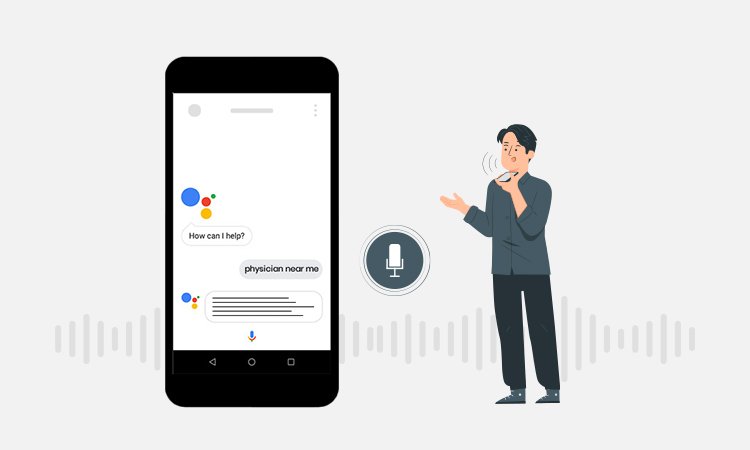
When you complete optimizing your healthcare content for voice searches, voice assistants like Siri, Alexa, and Google Assistant tend to feature the content as direct responses. Healthcare experts must write content in natural language and a conversational tone, just the way one interacts with a voice assistant.
Write healthcare content that sounds natural when someone reads it aloud. It will immensely help in voice search optimization. 21% of people use voice search regularly and have made it a part of their weekly routine.
You must respond to the common voice search queries through your content. Incorporating short sentences and simple words in your content can be great for your voice search optimization.
It is more likely for healthcare content to be complex. Thus, you need to write content in an easy-to-digest way so that it can accurately suit the type of response voice recognition software offers. You can structure your content to directly answer queries like ‘why’, ‘what’, ‘how’, ‘where’, and ‘when’.
11. Follow the Latest AI Trends

Latest AI trends like language models and generative AI play pivotal roles in the answer engine optimization for healthcare. These AI tools and AI models provide most of the AI-generated responses.
Thus, your healthcare content must be accurate and contain reliable medical information. The data you add to the content must be current to match these AI-generated responses.
For example, your website publishes current data based on recent events and keeps updating the content in response to user input. Google’s algorithm will prioritize your medical website to showcase its content in the featured snippets. Thus, you need to update your old healthcare content with current information.
12. Sign Up for AI-Powered Tools
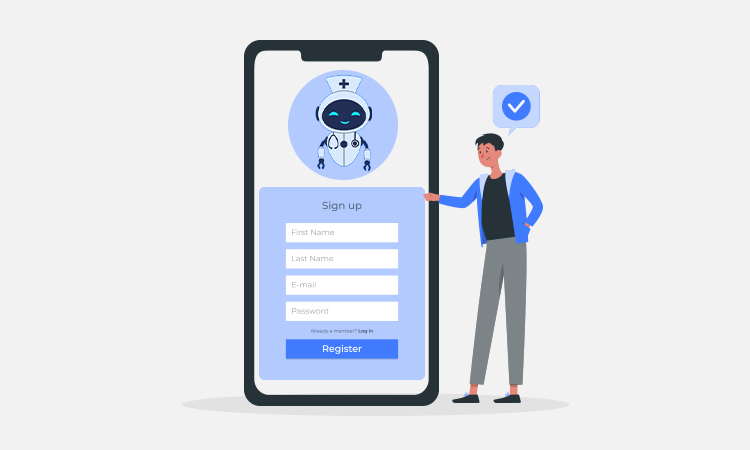
Do you know that AI resources like AI chatbots, FAQ creators, and voice assistants offer an early sign-up facility?
We suggest you sign up for these tools before you proceed with your healthcare AEO processes. You can use these resources while creating the content to understand how well the AI algorithm understands your content.
The more AI understands your content, the more likely your content is to get featured in the answer snippets of search engines. This early experiment can improve the user experience of your content.
5 Major Benefits of Implementing Answer Engine Optimization Strategies for Healthcare Business
AEO expands your healthcare business if you optimize its digital presence to make it featured in the direct responses of answer engines. It can bring several advantages to your healthcare practice that wants to shift its focus from SEO to AEO and thrive across online platforms.
The following five major benefits you can achieve through impactful AEO optimization for your healthcare business. Let’s have a look.
1. Enhanced Visibility
Answer engine optimization for healthcare can help the business reach a wider audience.
Want to know how?
When your healthcare practice appears in the quick responses of answer engines, a good number of users notice your business name.
These answer engine responses, like featured snippets, often appear at the top of the SERPs and naturally enhance the online visibility of your healthcare brand.
2. Better Click-through-rates (CTR)
AEO makes your healthcare content appear in the featured snippets, which often receive more clicks and user engagement. These prominent positions at the SERP can significantly increase your click-through rates.
These snippets appear at the top of the page, which increases the likelihood of users clicking on your website link to get more information.
3. Competitive Advantages
Though answer engine optimization can provide extensive advantages for healthcare practices, many medical organizations and professionals have still not implemented it. This has happened mainly due to their lack of knowledge related to these new content optimization techniques.
If you implement AEO in your healthcare marketing strategies, you can get a competitive edge and stay ahead of your market competitors.
4. Improved User Experience
AEO streamlines the process of searching for healthcare information online and receiving the appropriate responses more quickly. People can get their answers quickly without browsing through other web pages.
This makes them prioritize your healthcare brand as they can get quick and relevant answers to their healthcare queries through your website. All these positively contribute to the improved user experience.
5. Exceptional Brand Authority
Suppose your healthcare practice or the content present on your website has been selected as an answer engine response. This positions your healthcare practice as a credible medical resource.
When users get their desired responses to their healthcare queries through your site, they are more likely to trust your brand. It will also improve the overall brand reputation of your healthcare practice.
How Healthcare Professionals Can Track the Success of Their AEO Strategy with Useful Tools?
It is not enough to develop AEO strategies and implement the same for your healthcare practice. The professionals need to track the AEO performance and refine their strategy. You cannot expect the strategy to offer extraordinary benefits on your first attempt with AEO.
But when you keep tracking the success of your strategy, you get to identify the areas that need improvement.
How to effectively track the success of your answer engine optimization for healthcare strategy?
It needs you to follow a strategic approach. Certain useful tools can make the process easier and more impactful. We’ve explained the process in brief; let’s have a look.
- Track the Feature Snippets – You need to track the feature snippets to check how many pages of your healthcare site appear at the top of search results as their direct responses.
4.77% of all online search queries have a featured snippet. You can use tools like SEMrush and Ahrefs to notice when your healthcare content appears in the featured snippets of SERP.
- Track the Voice Search Responses – You need to check whether your content can be easily used by voice assistants like Siri and Alexa.
- Get Proper Insights – You can use Google Search Console to implement the ‘impression vs. clicks’ number. It will help you to see if people can find the answers without visiting your site.
- Utilize Google’s Rich Results – This will help you track the performance of the structured data. Additionally, you can schema markup generator to flawlessly develop structured data for better AI understanding.
- Research Keywords for the Queries – Tools like Google Keyword Planner and SEMrush can help healthcare professionals identify the keywords that their target audience mostly uses to ask any question in search engines.
For example, keywords like ‘how to’, ‘what is’, or ‘why does’ can be commonly present in healthcare queries.
- Check for the Click-through Rates (CTR) – You can use Google Search Console to track the rankings and CTRs of the keywords present in the healthcare search queries.
- Measure the AEO-optimized Pages – The next step is to monitor the traffic that your AEO-optimized web pages have brought so far. This way, you can identify the user behavior, bounce rates, and the time the visitor has spent on that specific page.
- Track Conversion Rates – It’s now time to track whether the users engage with your healthcare content further after they click on the instant answers provided by answer engines. Tracks whether they sign up, download, or schedule an appointment.
- Use Answer The Public – You can use this tool to get a list of the most commonly asked healthcare search queries. You can answer those queries through your content.
- PageSpeed Insights – Healthcare professionals can ensure their website pages load fast because this factor is crucial for voice search results.
- Refine and Upgrade Your Content – You’ll never notice a lack of content related to healthcare. Technology will emerge, and the industry will keep evolving. Thus, you need to regularly refine your content strategy as well as answer engine optimization techniques.
Furthermore, you can experiment with different content formats and structures to identify which one works best for your healthcare practice.
What Are the Common AEO Pitfalls that Healthcare Professionals Must Avoid?
Now that you have a complete understanding of how you can optimize your healthcare content for answer engines, it’s time to identify some common mistakes that you must avoid. These mistakes can hamper your AEO efforts.
When you identify these pitfalls, it will be easier for you to prevent them and ensure the success of your answer engine optimization for healthcare.
Here’s a list of some common mistakes healthcare specialists can make while optimizing their content for answer engines.
- Don’t stuff the keywords in your healthcare content. Otherwise, it will make your content look spammy.
- Natural placement of keywords has a higher chance of getting featured in the direct responses of answer engines.
- You shouldn’t create any medical content that fails to answer the common questions of your target patient market. For example, as a dentist, you should write ‘what are the benefits of regular dental cleanings, rather than ‘dental cleaning benefits.
- Never fill your healthcare content with too much information, especially with irrelevant data.
- Keep your healthcare content short with proper structure and accurate information. You must structure your content based on the H1, H2, and H3s.
- Incorporate tables, lists, and steps to get them featured on quick snippets as answer engines prioritize well-organized content.
- Keep your content updated and ensure it is according to the new AEO trends.
- Don’t avoid voice search optimization of your content. It’s crucial to craft voice-friendly content that appears as a chat and answers all the questions of the users.
The Future of Answer Engine Optimization for the Healthcare Industry
The future of online content search is artificial intelligence (AI). As more healthcare professionals benefit from AI, it will become the cornerstone to attract new patients and grow their practice.
Answer engine optimization is largely based on the AL algorithm, which will help healthcare practitioners optimize their content strategy more professionally.
Let’s explore how AEO can transform and evaluate the way healthcare businesses develop and implement their digital marketing strategy.
- Answer Engines Will Become More Efficient – Within some years, AI-based answer engines will be able to understand more complicated healthcare queries, even if the user hasn’t used the right keywords.
- Voice Search Will Gain More Popularity – A lot of patients will use voice search apps and tools for their healthcare queries. Likewise, the voice recognition technology will improve more in the future.
- Answer Engines Will Send More Than Text Answers – Answer engines will be able to create pictures, visuals, and interactive models to respond to the user queries better.
- You Will Get Personalized Responses – Answer Engines will provide the users with more customized responses to their queries.
- You Can Choose among Various Languages – Are the users comfortable with their mother tongue? In the future, answer engines will be able to respond in various languages based on the user’s preferences, even if the query is in another language.
- Answer Engines Will Feature Accurate Information – The answer engines will become smarter in the future and identify the content that is true and reliable. They will feature only the accurate content.
Conclusion
Healthcare professionals can achieve a higher search ranking or a top position in the SERP. Like any other industry professionals, healthcare specialists need to transform their online marketing strategy and adapt to the new digital advancements like answer engine optimization.
Healthcare businesses must own a professional-looking and AEO-optimized website from which answer engines can collect data to showcase in their direct responses to user queries.We hope that our comprehensive guide to answer engine optimization for healthcare will help you effectively optimize your healthcare content to get it featured as an answer engine response. But if this content optimization process still seems extremely complex to you, you can hire a reputable healthcare marketing agency that offers tailored answer engine optimization services.



























